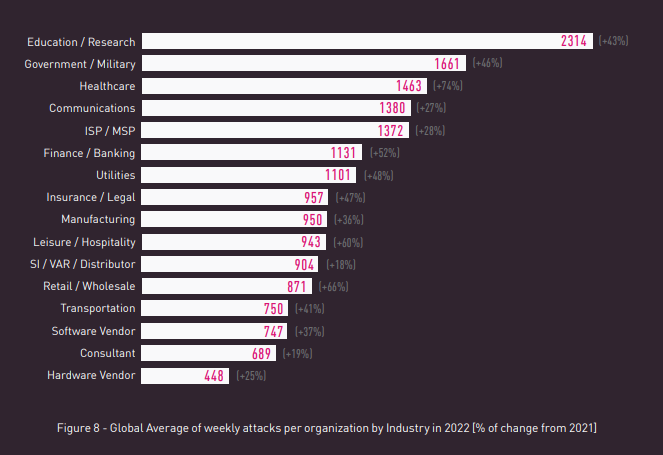Cyber attacks against all industries are on the rise again, according to data gathered in 2022. With an average of 2,314 attacks per week against each organization, a rise of more than 40% from 2021, educational and scientific organizations are the most frequently targeted.
The healthcare industry saw the largest increase in attacks, up 74% from the previous year, making it the third most targeted sector in this ranking.

Data from Check Point Software
Since the start of the COVID-19 epidemic, attackers have concentrated on the healthcare sector, targeting anything from hospitals and clinics to research institutes in an effort to profit. In the past year, 89% of healthcare institutions reported cyberattacks, with an average total cost of $4.4M.
The second-largest non-profit hospital chain in the US, Common Spirit Health, was among the targets of reported attacks. Patients were harmed medically as a result of the attack, which was reported by Common Spirit, which runs 140 hospitals.
In November, ransomware attacked hospitals in New York, causing medical systems to go offline for weeks.
Acute care operations were hampered by an attack on the Dallas-based Tenet healthcare partnership, which manages hundreds of medical facilities. Lockbit, BlackCat, Cuba, Zeppelin, and other ransomware outfits are among those said to target healthcare organizations.
A startling record of 86% of all file-based in-the-wild attacks are now transmitted by email, a rise in the percentage of email-delivered attacks. Data indicates a rise in the use of different archive file formats as threat actors try to hide dangerous payloads.
The functionality of malware is concealed until it is extracted from password-protected packages, making it difficult for security software to detect it as dangerous.
The most prevalent format for this is zip files, but.img and.iso files are also among the top malicious archive types, perhaps because their extraction capabilities is built into Windows or is available through well-known tools.
To get around the mark-of-the-web based protection system, archive files are frequently used.

